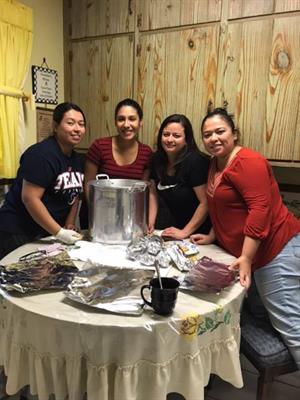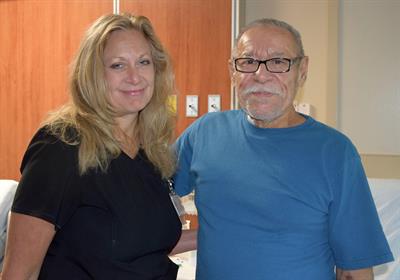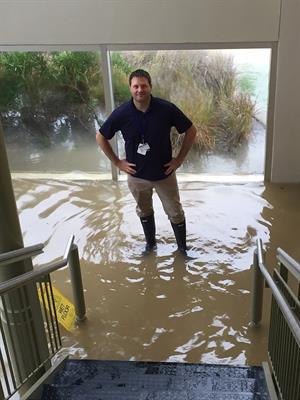We couldn't possibly recount every story of kindness, compassion, courage and self-sacrifice that occurred across our institution and in the surrounding communities during and after Hurricane Harvey. There are endless accounts of employees, students and volunteers going above and beyond, even when faced with the effects of flooding that experts are saying is a 1-in-1,000-year event. Here are just a few of the many examples that show
#WeAreUTMB.
 Feeding first responders
Feeding first responders
Beaumont Regional Maternal Child Health Program employees Christina Garcia, Karen Rocha, Vivian Chavez and Naomi Reyes kept in touch throughout the storm and wanted to give back to the community. They got together and cooked enough food to feed 49 members of the Cajun Navy, an informal network of boat owners from Louisiana who assisted in rescue efforts.
“I felt we were able to give back to the heroes, and we spent a few hours reconnecting with our own stories,” said Garcia, a maternal and child specialist.
In addition, RMCHP employees from around Southeast Texas banded together to collect supplies for two Beaumont RMCHP employees whose homes were flooded. The truckload of supplies was delivered by the spouses of Marlo Cochran, RMCHP administrative director, and Maria Lee, senior practice manager.
Behind the scenes

On any other day, the UTMB supply chain—purchasing, delivery and distribution—usually works behind the scenes. But during a historic flood, it’s one of the key factors that kept UTMB running and ready to meet the needs of the entire region.
During Harvey, UTMB’s Logistics team had to make sure there was enough food, medical supplies and linen for patients and employees who were sheltering in place at all three campuses. It wasn’t an easy task, as most of UTMB’s supplies come from hard-hit Houston, and distribution routes and methods were disrupted as flooding progressed over many days.
Preparations beforehand were important, like making sure each campus had enough supplies for four-plus days. As the flooding wore on, the team monitored supply levels daily and decided how best to conserve resources to keep everyone safe while extending the supplies on hand, said Frank Reighard, associate vice president of supply chain management.
The team continually evaluated the best and safest routes for getting needed materials to each UTMB campus. When regular trucks could not get through, the team helped arrange for unique transportation methods, such as an amphibious “duck boat” and Black Hawk helicopter. (See related story on page 6.)
After the storm, the team was instrumental in quickly obtaining materials for repairs and helping identify alternate sources for needs such as furniture for student housing for those students affected by flooding.
“It was a true 24/7 effort. Thanks to the flexibility of our Supply Chain teams, UTMB was there to serve people in a time of great need. We’re grateful to have been able to help,” Reighard said.
 The kidney transplant a hurricane couldn’t stop
The kidney transplant a hurricane couldn’t stop
As Hurricane Harvey closed in on Texas, Dr. Kristene Gugliuzza and UTMB’s Texas Transplant Center team performed a life-saving kidney transplant on the Galveston
Campus. Had the procedure not taken place in time, the opportunity for the transplant would have passed.
Not only did the surgery go well, but UTMB social workers made sure the patient, Hector Enriquez, had accommodations in Galveston afterward, since the weather made it
impossible for him to make it home to Beaumont.
“Quite a few people have been praying for me—it’s a miracle,”said Enriquez. “With the hurricane coming, we made it to UTMB just in time and everything worked out just right.
I’m doing really good, the kidney is working and I’m already feeling a lot better—everything has changed for me now.”
Ready to run

How do you get two very large rooms with network equipment and more than 325 computers with monitors, keyboards and mice set up in less than five hours?
You call UTMB’s Information Services team.
On Aug. 30, the team was called upon to get the Student Testing Center in Research
Building 6 re-equipped and ready for classes to resume. It was a huge task in itself, but many of the team members who would normally do the work could not get to the island because of flooding, said George Gaddie, associate vice president and deputy chief of Information Services.
An “all call” went out to IS staff in every division asking for volunteers to meet in the Testing Center as soon as possible. Less than an hour later, more than 30 people from Network Services and Clinical Information Services, along with the department’s two administrative fellows, were on-site putting things back in place.
The work involved crawling on the floor under desks, connecting cables and carefully
testing every item to make sure each worked properly. But each person was happy to be able to help get the job done, Gaddie said.
“Information Services pulled off what was seen as ‘impossible!’” he said. “We had
committed that the work would be completed by the end of the day on Aug. 31, and it was a great pleasure to confirm shortly after 4 p.m. on Aug. 30 that the work was done!”
UTMB students “First to Serve” in recovery efforts

The Phi Chi Zeta Medical Fraternity, made up of UTMB School of Medicine students,
lived up to their slogan of “First to Serve” by partnering with a local church to assist in the recovery efforts in the Houston-Galveston area. The first- and fourth-year medical
students were assigned to an especially hard hit location in Friendswood where many
homes received extensive water damage.
“We assisted in home repair, removal of damaged furniture, and various other tasks as
requested, but we were just a small group of the many UTMB students and employees who have worked since the storm to assist in the community,” said SOM student Shangir Siddique. “While we may be occupied with our medical studies, our primary goal remains to serve our communities in any way we can, be it in the clinic or helping our community
deal with disasters such as Hurricane Harvey.”
Through the water and back

With flood waters so high in League City on Aug. 26, Dr. Rafael Fonseca knew he wasn’t going to be able to safely drive his car to the hospital.
So, he packed his backpack and grabbed his bike. Trekking through water that at times covered his legs and tires, he said.
He knows the area well because he doesn’t live too far and often rides his bike around the area with his children, so he knew the drainage system. He tried to stay on the sidewalks whenever he could because the water was slightly shallower.
“It took way longer than normal because of the pressure of the water,” Fonseca said.
Taking this route two to three times a day was the only way he was able to get to the League City Campus, where he was working to take care of babies in the Level 2 nursery during Hurricane Harvey.
“I was soaking wet by the time I got to the hospital,” Fonseca said. “But we all did what needed to be done to take care of our patients.”
A jack of all trades
-(1).jpg?sfvrsn=a2659758_0&MaxWidth=250&MaxHeight=&ScaleUp=false&Quality=High&Method=ResizeFitToAreaArguments&Signature=E45C19D9A3FBF367ED266C36AC4FB699EEF14E8E)
As a self-proclaimed jack-of-all-trades, volunteer and member of Angleton Danbury’s Auxiliary, Larry Timeaus couldn’t just sit back and not help out at the hospital during Hurricane Harvey.
“We didn’t have much damage at my house,” Timaeus said. “And I knew there was going to be people needing help at the hospital.”
So, he showed up on campus to help with anything the administration needed, said Katrina Lambrecht, vice president and administrator of the Angleton Danbury Campus.
“His presence and his willingness to help was something I saw in every person who was at the hospital with us throughout the storm, but he is a shining example of it because he was not even called. He just came to help—exemplifying the spirit of so many,” Lambrecht said.
Care management during crisis

When a hurricane threatens UTMB, we often think about the care we provide to patients who are in the hospital, but not of the work it takes to help discharge patients safely with everything they need to remain healthy at home.
UTMB’s Care Management Department, with the support of its leadership team and Dr. Leah Low, was instrumental in discharging over 50 patients a day in the immediate aftermath of Hurricane Harvey.
The work of the team, including some who performed vastly different roles from their day-to-day tasks, was vital in ensuring that patients received necessary medications, were discharged to safe locations, and had resources available to them when they arrived.
Work is therapy

Stacey Laurey, a UTMB CMC nurse at the Jester III Unit in Richmond, never considered
not going to work, even when her home was submerged in over a foot of water and she lost her vehicle. Although she experienced a great deal of personal loss, she was able to get rides from other team members to and from the unit and help with everything from wound care to diabetes management and medication administration.
“I can honestly say that work, especially working for UTMB, has always been my therapy,” said Laurey. “I really love my job and love coming to work every day. There was lots to do at my house as far as ‘mucking and gutting’ as they call it, but I wanted to try and relieve some of my co-workers who had been at work for days.”
Providing medical care to evacuees

Like many others, Dr. Harold Pine, a pediatric otolaryngologist, watched helplessly as water crept closer to his house in Friendswood. Still, he knew others were in emergency situations and needed help, so he made his way to a local church, where he used his medical expertise to help evacuees who made it to the shelter. Whether he was making coffee, doing basic first aid or making a house call to help a baby with croup who couldn’t make it to the local ER, he worked throughout the night to comfort those that had lost everything.
By daybreak, Pine hitched a ride on a dump truck to Friendswood High School, where an entire nursing home had been evacuated. Many of the patients had chronic medical problems. Once there, he ran into several other UTMB employees who worked together to provide medical care and arrange a first aid table that included important medications.
“Developing mental toughness is a skill that can improve your performance in every area of life,” said Pine. “I try and work on this throughout the year but every once in a while you are faced with a situation that puts that training to the test. I watched friends and colleagues, both medical personnel, police officers, fire department teams and regular citizens rise to the occasion. There is more work to be done but we up to the challenge.”
 Ensuring the health and safety of patients, employees
Ensuring the health and safety of patients, employees
During the storm, UTMB’s Environmental Health and Safety staff went well beyond their regular duties, trudging through high water to check on buildings, mopping up water from roof leaks and helping League City Campus staff as emergency crews brought patients in from the flooded waters.
A team of six EHS employees, including Dean Leathers, Billy McBride, Mike Puccetti, Dan Marsh, David Blakeman and Jordan Sweet, rode out the storm at UTMB’s three campuses. Even before Harvey impacted the region, the crew worked around the clock to keep patients and employees safe by clearing buildings, construction sites and loading docks from debris and materials that could potentially become airborne. They also walked through all buildings to make sure fire alarms and other systems were functioning appropriately.
When the waters subsided, it was the EHS department’s responsibility to assess all UTMB facilities both on and off the island before allowing staff back into those areas. With the exception of a few hard hit clinics on the mainland, the majority of UTMB’s buildings stood up very well throughout the storm.
“It was an eventful week—and a challenging time for many of our co-workers living on the mainland—but it also showed the amazing character and resilience of the EHS department,” said Leathers. “I’m very proud to be a part of such a great team, as we like to say ‘EHS without borders.’”
Volunteering a helping hand

UTMB staff and volunteers with the RSVP Program of Galveston County, which is sponsored by the UTMB Sealy Center on Aging, stayed busy helping with Harvey relief efforts. Groups of volunteers mucked out seniors’ and veterans’ homes in Dickinson; and diaper, food and other donations were collected, sorted and distributed to Dickinson, La Marque and Santa Fe areas. In addition, more than $2,000 in gift cards was collected to distribute to area organizations helping with relief.
One of the first people to answer the call for help cleaning up seniors’ homes was David Hileman, administrator for the School of Medicine.
“David really came to the rescue,” said Ritchie Adoue, director of the RSVP senior program. “He has always been a strong supporter of our RSVP program and certainly proved it over the weekend! RSVP leads by example.”
Weathering the storm apart

Dawn Meyer, perioperative services coordinator, didn’t have a chance to say goodbye to her boyfriend, Jason Ziegler, assistant nurse manager for Transplant in Jennie Sealy Hospital, before Hurricane Harvey hit. She stayed at home with her 4-year-old son while Ziegler continued to provide care at the hospital for six long days.
While it was tough being apart during the numerous tornado warnings and never-ending rain, Meyer found comfort in knowing he was doing what he does best—taking care of patients.
“When he finally walked through the door, we literally ran to each other and hugged for what seemed like an eternity,” said Meyer. “I took him to dinner that night and was blessed to listen to his stories of how great his staff came together and never skipped a beat delivering the best patient care.”
Internal Medicine residents stay for the long haul

After working throughout Hurricane Harvey at Jennie Sealy Hospital, Sidra Qureshi, a chief resident of internal medicine, finally headed home on Aug. 31 to Sugar Land to help her family during a mandatory evacuation.
Tired, but still in high spirits, Qureshi took a moment to thank her fellow residents and faculty—many of whom pulled long hours with fewer staff, putting their personal worries aside to ensure the safety of more than 100 patients each night during the storm.
“I’m just so amazed and grateful for the hard-working residents we have,” said Qureshi. “Everyone had a positive attitude and was prepared to stay as long as our patients needed us. Some residents didn’t even want to leave after staying four or five days in a row! It was wonderful to see how committed they are to supporting patients and their peers.”
The Unsung Hero

Bobbie Bair, a coordinator in Angleton Danbury’s Nursing Administration department, came in from vacation and hit the ground running to make sure employees at the Angleton Danbury Campus were paid accurately during the chaos of Hurricane Harvey.
She also worked to repair the unit schedules so they could get back to normal as soon as possible and helped point out some staff members who should be relieved because they had been working so many continuous days.
“There was a significant amount of confusion over how to clock in and out of KRONOS when employees were sleeping/sheltering at the hospital,” said Katrina Lambrecht, vice president and administrator of the Angleton Danbury Campus. “Her work on this is invaluable.”